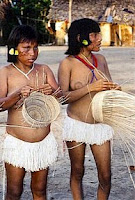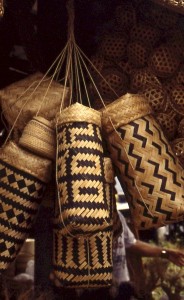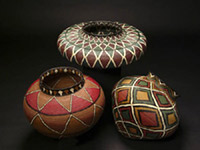 |
Rainforest environmentalism is eager to see the rainforest native as sharing the putative purity of the rainforest — closer to nature, less affected by the evils of the world, demonstrating the integrity of the unspoiled. The native of the rainforest is a monolithic figure, the keeper and companion of the plants and animals, an instrument to criticize our own civilization. That purity becomes associated with a wisdom we once had but have lost, and which we need to recover in order to rebuild what our technology has destroyed. Thus, the native is our guide — as anthropologist Bernard McGrane puts it, “our guide to nature, or our guide to the prehistoric past.” The wisdom of the rainforest stands ready to be reappropriated by the dominant culture.
In 1982, the home furnishings department of Macy’s in San Francisco had a show of primitive art from the Amazon. The display was set in a darkened area on the seventh floor, with jungle noises piped in through the sound system. Shoppers could read a brochure predicting how valuable the art would become, and the perils faced by Macy’s buyers in acquiring it. The brochure reiterates a number of themes that characterize popular attitudes toward Amazonian culture.
First of all, as we might expect, the jungle is dangerous — or at least uncomfortable. It has “pesty to poisonous insects and snakes, piranha-infested waters dotted with colonies of crocodiles, unbearable heat and humidity and virtual isolation from the rest of the world. With these things in mind, the crew proceeded — carefully.” Second, this dangerous jungle is filled with friendly, childlike natives. “There are twenty-three known Amazon cultures,“ the brochure says, incorrectly, “each one as diverse as the environment itself. But what was common to all was the warmth and excitement that greeted the crew when they arrived at the river banks…. The local chief would receive the travelers and then they would visit the houses to select the pottery, tools, baskets and other wares.”
 |
Moreover, these natives were innocent of commercial motives. “All of the pieces were made by traditional methods utilizing materials indigenous to the lush jungle environment…. Most importantly, these items were made for personal use, not commercial export, making them uniquely representative of tribal lifestyle and tradition.” These pieces, the brochure repeats — the “pottery, baskets, weapons, tools, ceremonial masks and objects” — were not made for commercial purposes “but created by the Indians for their daily and ritual uses.”
Childlike, noncommercial; one wonders just what these Indians were paid for their crafts. Note the combination of tropes, designed to move merchandise: the savage wilderness braved; innocent natives eager for American consumers to possess their goods. This innocence has been projected on the Amazon Indian since the Spanish and Portuguese conquest; their indifference to commodities such as gold made them appear like children in the eyes of their conquerors. As anthropologist Bernard McGrane puts it, “The Other is inferior to the European because he is not, as the European is, capable of having a responsible relationship with the gold that surrounds him, and hence the European appropriation of it is justified. This formulation we may term the Other-as-Child.” The perception of the colonized culture as fundamentally childlike feeds into the fantasy of the colonial civilizing mission, which is quite self-consciously fashioned as a form of tutelage — “a disinterested project concerned with bringing the colonized to maturity.”
Indeed, presenting these indigenous household goods as items for American interior decoration creates what Margaret Dubin, an expert on Native American art, calls “a pervasive sense of disjuncture,” a sense that these objects are out of place and unable to serve their original functions. Once removed from their cultural context, Chippewa artist David Bradley says, such objects lose “their real value and their reason for existence. They are flat; they have become the possessions of collectors.” The stereotype of innocent natives obscures their modernity, ensures their disappearance as human subjects. “Relegated to the silence of premodernity, living artists are transformed into objects, like mannequins in a museum diorama.”
 |
Like the Edenic rainforest, Edenic childlike natives need our protection. It is not that our culture will corrupt theirs, as an adult might corrupt a child. Rather, they have no culture — they are in a state of nature — because their culture has been reduced to a contextless set of pan-Amazonian household goods. They are the same as their environment; one is an idealized embodiment of the other; instead of a “multiplicity of worlds,” complex groups and individuals with varying needs and desires, they become an endangered species.
Ayahuasca tourism has brought new attention, new money, and new problems to traditional healers and their communities, and has created a market for the misrepresentation of traditional practices and the exploitation of eager and innocent tourists. The marketing of ayahuasca shamanism is in many ways akin to the marketing of Amazonian household goods at Macy’s — the dangerous yet pristine landscape, the spiritual natives eager for American consumers to possess their wisdom; the chance for the tourist, in imitation of the archetypal Manuel Córdova-Ríos, to bring back the redemptive secrets of the Edenic rainforest, as decontextualized as an indigenous basket on a suburban wall.

- Previous Post: Metachoric Experiences
- Next Post: How Old is Shamanism?
- More Articles Related to: Indigenous Culture, The Amazon


